 Nafarelin acetate is the generic name for “Synarel,” a medicine that is used to treat endometriosis. It is a type of gonatropin-releasing hormone agonist (GnRH agonist) medicine. GnRH agonist medicines help to lessen pelvic pain caused by endometriosis.
Nafarelin acetate is the generic name for “Synarel,” a medicine that is used to treat endometriosis. It is a type of gonatropin-releasing hormone agonist (GnRH agonist) medicine. GnRH agonist medicines help to lessen pelvic pain caused by endometriosis.
How does Synarel work?
Synarel works by shutting off hormones made by the ovaries, so estrogen (one of the hormones that cause your body to have periods) is lowered. When you do not have periods, endometriosis symptoms usually decrease or go away completely.
How is Synarel taken?
Synarel is a nasal spray that is typically prescribed as: 1 or 2 sprays in one nostril in the morning and 1or 2 sprays (in the other nostril) in the evening (about 12 hours apart). It is very important to take Synarel at the same times every day without missing any doses.
Are there any reasons that I shouldn’t take Synarel?
You should NOT take Synarel if:
- You have an allergy to Synarel (Nafarelin acetate) or any part of the medicine. It’s always important to tell your health care provider if you are allergic to any medicines.
- You have vaginal bleeding and the cause is unknown
- You are pregnant and/or breast-feeding
*Make sure you tell your health care provider about all of the medicines you take including over-the-counter herbs and supplements.
Before starting Synarel you should:
- Have a pregnancy test (if you are having sex)
- Talk to your health care provider (HCP) about whether you are at a higher risk for bone density problems (how solid and strong your bones are) and whether you need to have a bone density test before you start the medicine.
- Know that it usually takes a few cycles to see an improvement in symptoms.
What are the possible side effects of Synarel?
All medications can cause side effects. Some people have mild side effects; most people have no side effects. Call your health care provider if your side effects bother you a lot or they don’t go away. Taking Synarel alone (without add-back) lowers the estrogen level in your body, which typically causes side effects that are similar to menopause. These side effects may include:
- hot flashes or feeling warm-hot with flushing of the skin
- moodiness
- decreased interest in sex
- acne
- vaginal dryness
- headache
Nasal irritation and/or a runny nose are also possible. Serious side effects are rare.
Other uncommon side effects that you should tell your health care provider about include:
- inflammation/irritation of your nose
- rash
- pain in your belly area
- heavy vaginal bleeding
- vaginal spotting/bleeding for more than 2 months
- sadness or symptoms of depression that lasts longer than 2 weeks
- trouble with remembering things
Where should I keep my Synarel?
- Store it upright, in a dry place (not in the bathroom)
- NEVER keep Synarel in the refrigerator or freezer
- Protect it from direct sunlight
- Keep it away from young children and pets
Synarel is usually tolerated well however sometimes some young people may have mild to severe reactions. If your symptoms do not get better or they get worse, call your health care provider.
| 1. Think about a way to remember to take your Synarel medicine- Example: Set your cell phone alarm. | |
| 2. Keep track of each dose of Synarel that you take. Ex. Using a calendar or checklist. | |
| 3. Use the bottle of Synarel for up to 30 days then open up a new bottle. If your health care provider or gynecologist increases your dose, you will likely run out of medicine before 30 days are up. | |
| 4. Prime the bottle of Synarel (before you use it for the first time). | 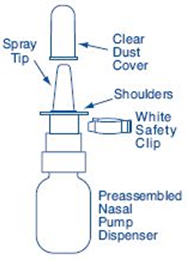 |
|
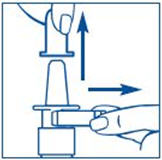 |
|
|
|
|
|
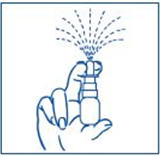 |
|
|
|
|
|
|
| 5. After you prime the bottle, you’ll need to: Clean the spray tip. | |
| 6. Hold the bottle side-ways and run it under warm water for about 15 seconds. Use a clean paper towel or clean cloth to dry the tip. | |
| 7. Place the white safety clip back on the neck of the bottle and cover the nozzle tip with the cap. | 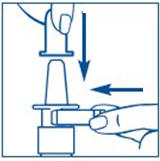 |
| 8. Never poke anything into the spray tip or take it apart. |
Follow these directions EVERY time you take your medicine (Synarel)
| 1. Gently blow your nose before you use Synarel. | 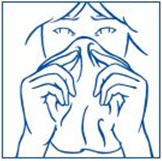 |
| 2. Remove and save the safety clip from the neck of the bottle. | 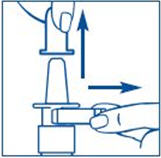 |
| 3. Clean the spray tip by holding the bottle sideways. Rinse the tip under warm water for 15 seconds. Dry the tip with a clean cloth or paper towel. | |
| 4. Bend your head forward and place the tip of the bottle in your nostril. The tip should feel comfortable. | 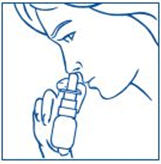 |
| 5. Aim the spray towards the back and outer side of your nostril. | |
| 6. With your other hand, place one finger on the opposite nostril and push it until the nostril closes. | 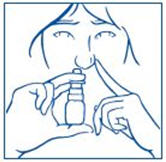 |
| 7. Using even pressure, squeeze down on the sides of the nozzle/spray (pumping the spray 1 time) while you gently sniff in the mist. | |
| 8. Take the nozzle/spray tip out of your nostril and gently tilt your head back for a couple of seconds to allow the medicine to reach the back of your nose. | 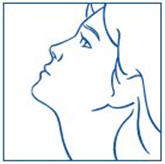 |
| 9. Clean and dry the medicine tip and replace the cap and the safety tip. | 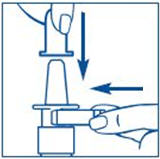 |
| 10. Store your medicine upright, away from direct light. Keep your medicine in a safe place away from young children and pets. NEVER store Synarel in the refrigerator or freezer. |
Images used with permission from Pfizer
Our health guides are developed through a systematic, rigorous process to ensure accuracy, reliability, and trustworthiness. Written and reviewed by experienced healthcare clinicians from Boston Children's Hospital, a Harvard Medical School teaching hospital and consistently ranked as a top hospital by Newsweek and U.S. News & World Report, these guides combine clinical expertise, specialized knowledge, and evidence-based medicine. We also incorporate research and best practices from authoritative sources such as the CDC, NIH, PubMed, top medical journals, and UpToDate.com. Clinical specialists and subject matter experts review and edit each guide, reinforcing our commitment to high-quality, factual, scientifically accurate health information for young people.